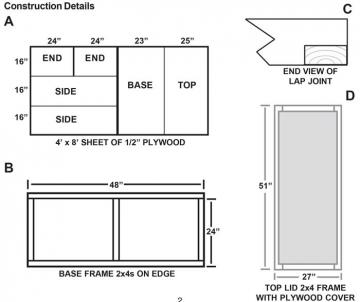Division of Environmental Quality Director: Art Goodin
Vermicomposting is composting with worms, which can compost garbage faster than any other type of composting method. Worms also are very efficient in digesting kitchen food wastes. Each day a worm eats half its weight in food. The care and feeding of worms take far less effort than maintaining an outdoor compost pile. A worm bin is a self- contained system. As with any system, several components are involved. This system is composed of a box to contain the worms, the worms themselves, a controlled environment and regular maintenance. Some of the benefits of keeping a worm bin include recycling kitchen food waste, reducing waste disposal costs, producing soil amendments or fertilizer for house and garden plants and having a ready supply of fishing worms.
Bin Construction


Materials:
- 16d nails
- 4d nails
- one 4' x 8' sheet of 1/2-inch plywood
- one 14 foot 2" x 4"
- one 16 foot 2" x 4"
- 2 hinges
Measure and cut the plywood as indicated in drawing A. Cut the 14 foot 2" x 4" into six pieces: two 48", three 20" and one 12" lengths. Cut the 16 foot 2" x 4" into seven pieces: three 12", two 51" and two 27" lengths.
To assemble the base, lay two 48-inch and three 20-inch 2" x 4" on edge as shown in figure B. Nail the 2" x 4"s together with two 16d nails at each joint. Nail the plywood piece onto the 2"x 4" frame using the 4d nails.
To make the sides, place a 12-inch 2" x 4" under the end of each side panel so the 2" x 4" is flush with the top and side edges of the plywood. Nail the boards into place with 4d nails. Use 16d nails to attach the side pieces to the base frame. Using 4d nails, nail the end plywood to the base and sides. To reinforce the box, place a 16d nail at least every three inches wherever plywood and 2" x 4" meet. Drill twelve 1/2-inch holes through the bottom of the box for drainage.
To assemble the lid, lay two 51-inch and two 27-inch 2" x 4" as shown in figure D. Cut lap joints in the corners (see figure C), then glue and nail the frame together with 16d nails. Center the plywood onto the 2" x 4" frame and nail with 4d nails. Lay the top on the ground with the plywood surface touching the ground. Attach hinges to the top and back. Position hinges so the screws go through the plywood and 2" x 4".
Bin Use
Once the worm bin is built, make bedding for the worms with shredded and moistened newspaper or cardboard. Maintain the system by burying food wastes throughout the bin on a rotational basis. Every three to six months, move the compost to one side of the bin and add new bedding to the empty half. The worms will soon move to the new bedding. Harvest the compost and add new bedding to the rest of the bin.
Frequently Asked Questions About The Worms
What kind of worms should be used?
Red worms are the most satisfactory to use in home vermicomposting systems. They process large amounts of organic material in their natural habitats of manure, compost piles or decaying leaves. They reproduce quickly and in confinement. The species of red worm best suited for a worm bin is Eisenia foetida pronounced “I see nee a fet id a.” Eisenia foetida is known by several common names: red worm, brandling worm, red wiggler, manure worm and fish worm among others. Starter worms of this species for a worm bin may be found in old compost piles (ones that no longer generate any heat) or from local bait suppliers.
What do worms eat?
Any vegetable waste generated during food preparation such as potato peelings, grapefruit and orange rinds, cantaloupe and watermelon rinds, outer leaves of cabbage and lettuce. Plate scrapings, spoiled food from the refrigerator, coffee grounds, tea leaves or egg shells are waste you may want to feed your worms. Burial of meat is not recommended because decaying meat can produce offensive odors. Mice and rats are more likely to be attracted to worm bins containing meat. Some other things that don’t belong are plastic bags, bottle caps, rubber bands, sponges, aluminum foil and glass.
How much do worms eat?
It is recommended that the worm to garbage ratio be 2:1. Worms are usually sold in terms of “pounds” rather than number. Use one pound of worms (about 1,000) to 1/2 pound of daily garbage. An average family of four generates about seven pounds of compostable garbage per week. To create an environment for the worms to “eat” this much garbage, the worm bin should be equal to one square foot of surface for each pound of garbage per week.
Do worms die in the box?
Worms will die in any home worm bin, but in a properly maintained worm bin, you will rarely see a dead worm.
How long does a worm live?
Most worms probably live and die within the same year. Yet, in culture, Eisenia foetida, the type of worms in this box have been kept as long as four and a half years.
For More Information
- Appelhof, Mary. Worms Eat My Garbage. Kalamazoo, MI: Flower Press. 1982. 100p
- Goldstein, Jerome. Recycling. New York: Schocken Books. 1979. 238p
- Henwood, Chris. Keeping Minibeasts: Earthworms. London:Franklin Watts. 1988. 29p
- Jennings, Terry. Junior Science: Earthworms. New York: Gloucester Press. 1988. 24p
- Martin, Deborah and Grace Gershuny. The Rodale Book of Composting. Emmaus, Pa: Rodale Press. 1992. 278p
Nothing in this document may be used to implement any enforcement action or levy any penalty unless promulgated by rule under chapter 536 or authorized by statute.
For more information
Waste Management Program
Division of Environmental Quality
P.O. Box 176
Jefferson City, MO 65102-0176
United States
